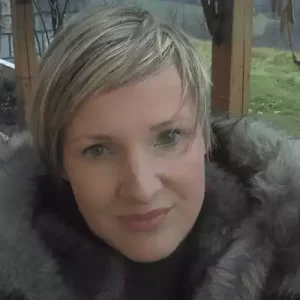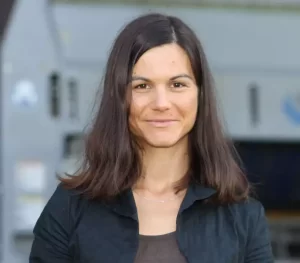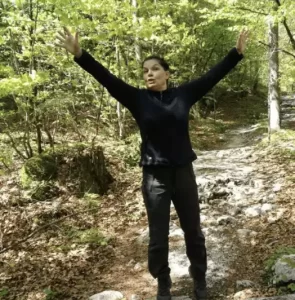
When I first read Aleš’s book “Lahkotno iz kroničnih bolečin,” I only partially understood the importance of AEQ exercises.
Home » AEQ method testimonials » When I first read Aleš’s book “Lahkotno iz kroničnih bolečin,” I only partially understood the importance of AEQ exercises.
For many years I’ve had problems with my spine. Physiotherapy and occasional exercises for acute pain only had a short-term effect. Visiting a chiropractor also didn’t bring a long-term effect or an end to the pain. Working an office job, as well as a lack of exercise, led to my condition becoming worse. Years of bad habits, too much sitting, insufficient movement, the pace of life, and the rush cause the body to become stiff and stiff. At the workshop, I listened very carefully to Aleš as he presented the exercises and said that in this way, sensory-motor amnesia could be eliminated; he explained the importance of a state of optimal synergy and conscious feeling and control. I felt the difference after the first exercises. However, I understood the importance of AEQ clinical somatics only later during individual therapies.
Daily exercises at home, along with all the information that Aleš gave me and a conversation about past events, gave me many answers. Pain shows what things you shouldn’t be doing, and through the exercises of AEQ somatics, you begin to increasingly understand and change and can eliminate the cause of pain. But this is achieved with more and more knowledge and feeling of what is constricted and how this constriction changes to where it actually is.
During the exercises, I carefully focused on the movements, and from the beginning, I first purposely went until I felt slight pain to actually feel my muscles. With the mind, it is necessary to connect the movement with the muscle in order to have an effect. Now I immediately notice if I do something too quickly or with insufficient attention, I consciously observe and, at the same time, monitor the feelings that arise. The more gentle and conscious the movements are the more pleasant the feeling in the body. During my research, I was looking for exactly these feelings, and it is precisely with this that the exercises become a game; soft, relaxed play with your body. All this breadth of changes, which I understand more and more and thereby control, raises the quality of life and, in many areas, more and more balance. When you start to accept yourself more, it becomes more and more accessible to change. You are consciously looking for a gentler and more emotional way of improvement, combining the sensations you get from your body with the awareness of what you want. Conscious communication in all areas is important.
For a long time, I have been working on myself and on being aware of the present moment, what and how I see and understand the surroundings, and how I react, and now, after AEQ clinical somatics, this awareness is even stronger, reinforced by strong feelings in the body.
At first, I observed this awareness with my mind, in my head, but now the mind is more connected to the body than before. Due to exercises and a different feeling, there are changes in the mobility of the pelvis, along with the body being softer and more relaxed. The connection of the pelvic floor with the conscious part of the mind is very important. I am careful when walking; the pelvis’s movement is in line with the shoulders, and walking is more relaxed. The exercises also led to stronger reactions, fears, memories, and repressed emotions coming from the inside, and I became aware of some things that I had already forgotten or did not attach much importance to.
I am working on being in my center, calm, focusing on myself, my feelings and reactions, communication, and my attitude towards everything. A lot of learning and quality improvement is based on experience and wisdom. All the sensations in the body, the circulation of this pleasant energy, and all the changes I felt in the body result from increased awareness of the muscles and the body and, accordingly, a greater ability to lengthen and shorten the muscles and relax.
During the exercises, I do the movements even more slowly, playfully, and in such a way that I feel nice vibrations in my body and consciously focus on looking for pleasant sensations. It’s an interesting feeling during the exercises when you can see and feel yourself consciously doing these movements and simultaneously feel the sensation. Doing the exercises gently and slowly and within a painless range is important. Aleš says that this is the correct progress of feeling and thus changes in emotional, movement, and behavioral patterns because, based on feelings and pain, we change the functioning of consciousness and, with it, the future. I react more consciously in different situations, quickly see the real picture, and start looking for solutions to problems or reactions in relationships. I feel myself and my reaction, and I also quickly recognize the behavior of others and stop, try to understand it, and do not get involved in others or in what is not important to me.
Aleš teaches us that the more we feel our body and are able to connect our mind and body, the more we know who we are and how we feel. This is the only way we know what we want and how to achieve it. We can better direct energy towards the easier achievement of goals, fulfillment of desires, and satisfaction of needs. We perceive situations differently, and as a result, we react differently. This way allows you to make changes based on seeing more broadly and actually understanding what is going on. But when feelings support it, awareness is even clearer. A sense of one’s body develops, leading to balance and greater health.
In the process of performing the exercises, emotional blockages are also released, this started to happen most strongly after the activation of the psoas muscles, which are also called the “muscle of the soul.” Not only our physical but also psychological well-being depends on them. As they relax, so does our physical and emotional trauma. Contracted muscles signal the body that it is in danger. Aleš gave me information in a simple and very effective way so that I understood what and why certain actions were happening in my body in the first place. During therapies, he also suggested a few books to me, which have provided me with improved perception and understanding. We relax the psoas muscle only when we change our attitude towards ourselves and become increasingly tendered on all levels.
Suppressed emotions are released through such a change towards oneself, and a change in thinking about oneself and the past, and crying is one of the ways to release suppressed and repressed emotions from oneself. It is also important that you are consciously aware of what’s happening and don’t lock yourself inside again because this will prevent long-term changes. Now I am more aware of my body, muscles, and walking, and I pay attention to my posture, my body is softer and more relaxed. I am still in the process of change, but now I have a lot of information, and I know that this is the right thing for me, the pain is almost gone.
Thank you, Aleš, for everything I learned and for helping me with all the physical and mental changes. I would call it true psychosomatic therapy. I still have a lot of work to do, but slowly, with conscious movements, you can go a long way. This is not work, but a game of movements, without strain, with good feelings towards health and easy movement.
Dušica Gabriel






